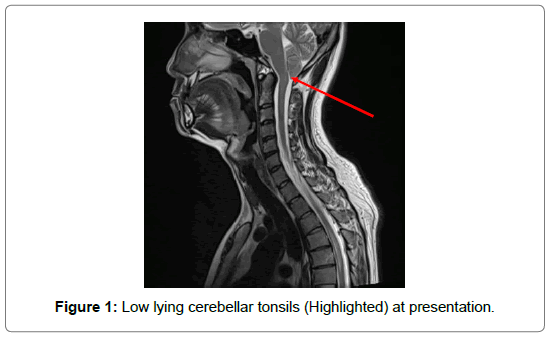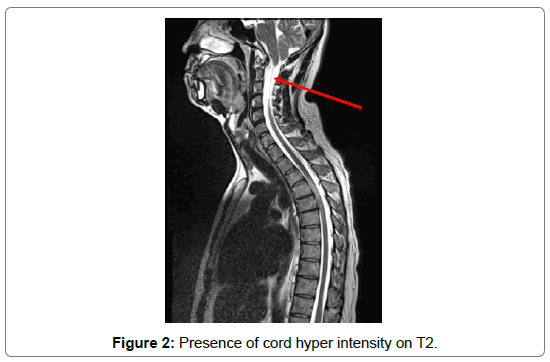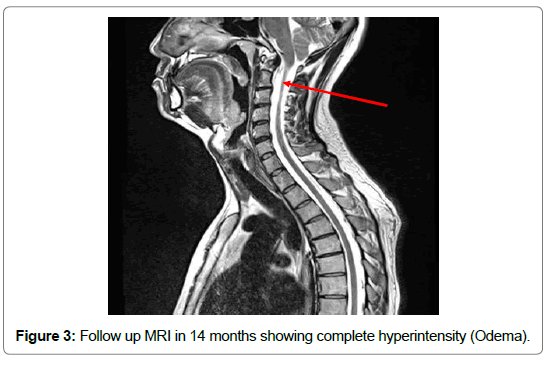Chiari Type 1 Malformation Presenting as Red Herring in Neurosyphilis
Received: 09-Jul-2020 / Accepted Date: 23-Jul-2020 / Published Date: 30-Jul-2020
Abstract
30-year-old male who presented with urinary retention and gradually worsening bilateral lower limb weakness, but this was missed. Initially treated as urinary infection, subsequent visits earned him a Magnetic resonance Imaging (MRI) that revealed T2 hyper intensity and low-lying cerebellar tonsils. Further evaluation by consultant revealed discordant findings to Chiari malformation. Subsequent investigation led to the diagnosis of Neurosyphilis. Importance of senior input, understanding of disease complex, lateral thinking, multidisciplinary involvement and prompt intervention prove central to the management of this patient whom otherwise may have been treated dangerously and inappropriately as symptomatic Chiari malformation.
Keywords: Red Herring; Chiari Type 1 Malformation; Neurosyphilis
Introduction
Neurosyphilis specifically can be classified into early and late stages, both of which have different presenting regions. Early syphilis includes the involvement of the meninges, cerebrospinal fluid and various vascular structures [1].This is in comparison to late syphilis which tends to affect the parenchyma, cerebral tissue and the spinal cord [2]. Symptoms of neurosyphilis include abnormal gait, incontinence and peripheral numbness [3]. Case of a 32-year-old man presented with 1-week history of urinary retention and gradually worsening bilateral lower limb weakness. This was initially treated as urinary tract infection. However, he later returned with acute urinary retention, needing bladder catheterization. Whole spine Magnetic Resonance Imaging (MRI) revealed low lying cerebellar tonsils associated with hyper intensity at the cervicothoracic region (Figure1-2). Based on these findings, the diagnosis of Chiari malformation was considered by neurosurgical trainees with a potential plan for Chiari decompression. Consultant review revealed a more detailed history of mild bilateral lower limb weakness that had affected his driving. Examination revealed weakness over the left L2-L3 region (MRC scale 3/5) and L4-S1 (MRC scale 4/5) associated with segmental sensation reduced over T4-T9 bilaterally almost symmetrically. There was impaired proprioception and ankle and knee reflexes were exaggerated. These findings were deemed unusual for the more predictable constellations of symptoms seen in Chiari type 1 malformation, which has other dominant features. Suspicion of a medical cause was investigated. This revealed VDRL (Venereal Disease Research Lab) RPR reactive (Titre 1:128). Treponema Pallidum Particle Agglutination test (TPHA) was positive. CSF analysis revealed elevated total cells of 56 cells/mm3, all being lymphocytes. Protein level was 76 mg/dl; Glucose and Chloride levels were normal. CSF cultures were negative. CSF for VDRL was not available in our laboratory. Clinical diagnosis of Neurosyphilis was made based on these findings. Patient was started on Intravenous C-Penicillin 4 mega units, given every 4 hours for a week. This was followed by Procaine Penicillin 2.4 Mega units and Probenecid 500mg 4 times a day for 1 week. A repeat CSF analysis at 3 months revealed 2 cells/mm3, with reducing CSF protein of 47 mg/dl. Repeat MRI Spine at 14 months post-treatment showed a completely resolved lesion with full clinical recovery of paresis and par aesthesia. Hence the hyper intensity initially reported as syringomyelia was likely cord oedema misinterpreted (Figure 3). The low-lying tonsils were an asymptomatic finding. This report emphasizes the importance of a detailed history and examination in a consultant led service, in otherwise what may have turned out to be a missed diagnosis with potential intervention and serious harm to the patient. Although Neurosyphilis is a rare condition, correct diagnosis and first line antibiotics can reverse the disease and disability in many patients. A high index of suspicion is needed when the clinical condition does not match the radiological. It also warns the prevalence of low-lying tonsils and necessity not to ‘overtreat’ this condition even in the case of Chiari 1 malformation. Instead control of the symptoms and a close follow up may be beneficial. However, this aspect is beyond the scope of this report.
References
- Pastuszczak M, Wojas-Pelc (2013) Current standards for diagnosis and treatment of syphilis: Selection of some practical issues, based on the European (IUSTI) and U.S. (CDC) guidelines, Postepy Dermatologii Alergologii. Adv in Dermat Allerg. 4: 203-10.
- Basic V, Podobnik Sarkanji S, Seric V, Demarin V (2017) Neurosyphilis: A case report. Acta Clinica Croatica, 39: 47-49.
- Berger J, Dean D (2014) Neurosyphilis. In J. Biller & J. Ferro, Handbook of Clinical Neuro. 121: 1461- 72.
Citation: Ansari DM, Aizad KA, Chung W, Vashu R (2020) Chiari Type 1 Malformation Presenting as Red Herring in Neurosyphilis. J Neuroinfect Dis 11:293.
Copyright: © 2020 Ansari DM, et al. This is an open-access article distributed under the terms of the Creative Commons Attribution License, which permits unrestricted use, distribution, and reproduction in any medium, provided the original author and source are credited.
Select your language of interest to view the total content in your interested language
Share This Article
Recommended Journals
Open Access Journals
Article Usage
- Total views: 2500
- [From(publication date): 0-2020 - Nov 11, 2025]
- Breakdown by view type
- HTML page views: 1693
- PDF downloads: 807



